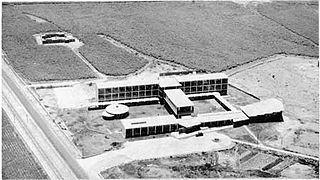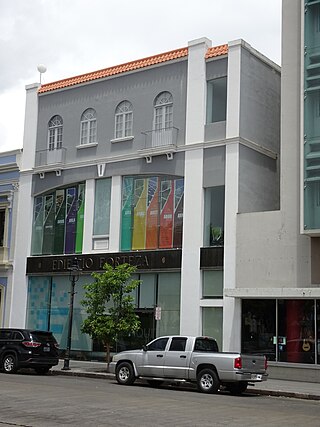

The Escuela de Arquitectura de la Universidad de Costa Rica is the principal school of architecture in Costa Rica. It is part of the Faculty of Engineering at the University of Costa Rica.


The Escuela de Arquitectura de la Universidad de Costa Rica is the principal school of architecture in Costa Rica. It is part of the Faculty of Engineering at the University of Costa Rica.
The School of Architecture of the University of Costa Rica was founded in 1971. Prior to that year, the few architects that were in the country, had studied mainly in México, Chile, and the United States, which means that construction was primarily regulated by civil engineers, who left their mark and perspective around the entire country, but with the insertion of many new architects, it is being reoriented toward a vision that is architectural in character.
The first director of the School was the plastic artist Rafael Ángel “Felo” García and the first architect graduated in Costa Rica is Ibo Bonilla Oconitrillo who has distinguished himself internationally in bioclimatic architecture and as a sculptor of the highest sculptures in the country.
The new school started with controversy given its innovative curriculum, different from the traditional, basing its focus of the architectonic object as a part of an urban process and creating results based on its consideration of the physical and cultural environment.
Architects Jorge Bertheau, Rafael Ángel García, and Édgar Brenes implemented the teaching methodology based on integrated multidisciplinary studies, with emphasis on teamwork and real projects applied to specific communities. They obtained a scholarship to study the architecture in England.
The career includes an academic program to obtain a degree in 5 years. Nevertheless, it is uncommon for a student to complete the degree within the 5 years along with the required thesis. The system is academically open, in that the student decides how many and what specific courses he wants to carry each semester.
The primary axis of the career program is in the area of design. Thus, 10 workshops on design are imparted, within which the student is challenged with various kinds of design problems: that can go from designing a cafeteria to a high rise. Complementary to the area of design, there are theoretical courses (which deal with, but not limited to theory on architecture), supplementary subjects, which are required by the University of Costa Rica, such as courses in art, sports, humanities, history, etc.
• Urban Design: with a concentration on developing proposals consistent with urban design, focusing on the Latin American reality and the behaviors of its inhabitants.
• Tropical Architecture: its intent is to address architecture from the reality of Costa Rica’s climate, which encompasses tropical zones, with huge contrasts temperatures and humidity. Also, part of the emphasis of this masters program, is the intent to guide the designer towards the bioclimatic trends of design.
• Technology and Construction: its purpose is to guide the professionals towards an adequate use of technological tools applied to construction. It exposes the participants to the most recent innovations in the field, while simultaneously complementing the students formation with talks and additional materials.
• Landscaping: it deals with the relationships among architecture, the human being, and the environment with a scope controlled and defined by man. It studies more deeply the diversity of plants and construction materials from a naturalistic orientation, and how these relate to a human environment.
There are various requirements:
• Have completed secondary education, including the exams of the Ministry of Education of Costa Rica.
• Have completed the admission exam of the University of Costa Rica, and have obtained on the exam, the required score needed to make it into the field of study (the score varies from year to year).
• Pass the aptitude test from the School.
Each year, about 1000 students who obtained the minimum score on the admission exam of the university, can enroll to take the aptitude test. Approximately 70 pass it and are admitted to study architecture.

A civil engineer is a person who practices civil engineering – the application of planning, designing, constructing, maintaining, and operating infrastructure while protecting the public and environmental health, as well as improving existing infrastructure that may have been neglected.

The University of Puerto Rico, Río Piedras Campus is a public land-grant research university in San Juan, Puerto Rico. It is the largest campus in the University of Puerto Rico system in terms of student population and it was Puerto Rico's first public university campus.
The “Master of Architecture”(M.Arch or MArch) or a “Bachelor of Architecture” is a professional degree in architecture, qualifying the graduate to move through the various stages of professional accreditation that result in receiving a license.

The University of Costa Rica is a public university in the Republic of Costa Rica, in Central America. Its main campus, Ciudad Universitaria Rodrigo Facio, is located in San Pedro Montes de Oca, in the province of San José. It is the oldest and largest institution of higher learning in Costa Rica, originally established as the Universidad de Santo Tomás in 1843. It is also the most important research university in the country and Central America and is counted among the most prestigious universities of Latin America. Approximately 45,000 students attend UCR throughout the year.
The Pontifical Catholic University of Puerto Rico is a Roman Catholic university with its main campus in Ponce, Puerto Rico. It provides courses leading to Bachelor's, Master's and Doctorate degrees in education, business administration, the sciences, and arts and humanities. It also has campuses in Arecibo and Mayagüez, as well as a satellite extension in Coamo. It is also home to a School of Law and a School of Architecture. The university also founded a medical school, Escuela de Medicina de Ponce, in 1977, but in 1980 became an independent entity that eventually became the Ponce Health Sciences University.
The University of Medical Sciences is a private medical university in San José, Costa Rica. It is the largest and oldest private medical school in Costa Rica and one of the most prestigious in Latin America. Currently the main campus is located in the country's capital with the latest technology in medical education and one of the best simulated hospitals in the region. The university offers a great variety of degrees such as Doctor of Medicine, Doctor of Microbiology and Clinical Chemistry, Licentiate of Physiotherapy, Licentiate of Nutrition and Doctor of Pharmacy. UCIMED also offers master's degrees and medical specialties such as a Master's Degree in Health Management and Specialty in Gynecology and Obstetrics.

The University of Puerto Rico School of Law is a law school in Puerto Rico. It is one of the professional graduate schools of University of Puerto Rico, Río Piedras Campus and the only law school in the University of Puerto Rico System. It was founded in 1913 at its present site in Río Piedras, which at the time was an independent municipality and is now part of the City of San Juan. The School of Law has been accredited by the American Bar Association since 1945 and by the Association of American Law Schools since 1948.

The Faculty of Architecture, Urbanism and Arts commonly referred as FAUA is one of the eleven constituent faculties of the National University of Engineering located in Lima, Peru. It was founded in 1910 as the Special Section of Builders Architects making it the first school of architecture to be established in Peru. The faculty is traditionally known as one of the leading schools of architecture in Peru because it paved the way of architecture in the country. Also, it is an accredited school by the Royal Institute of British Architects.

The School of Architecture at UNAM is one of the leading schools of architecture and design in Mexico. It offers undergraduate and postgraduate studies in architecture, landscape architecture, urbanism and industrial design.

Ibo Bonilla Oconitrillo is an architect, sculptor, mathematician and educator of Costa Rica. He has Costa Rican and Spanish nationality.

The Pontifical Catholic University of Puerto Rico School of Architecture is an institution of higher learning granting degrees in the field of architecture. It is located in the Ponce Historic Zone, across from Plaza Las Delicias. It was established in 2009. Together with the School of Law, it is one of two semi-autonomous professional colleges of the Pontifical Catholic University of Puerto Rico (PCUPR) in the city of Ponce, Puerto Rico. In 2010, the school won an award from the Southern Puerto Rico Chamber of Commerce for Valor del Año en Educacion. The school is accredited by the National Architectural Accrediting Board (NAAB). It has a teaching staff of 40 and a student body of 300. The current dean of the school is Luis Badillo Lozano.

Richard Moreta Castillo, also known as Richard Moreta, is an American architect, urban planner, industrial designer, artist, and a diplomat.
Juan Miró is a Spanish-American architect. He is Director of the Studio Mexico Program and a professor at the University of Texas at Austin. Professor Miró has directed Studio Mexico since 1998, a program that affords students the opportunity to travel to and explore Mexican culture through the study of architecture, drawing, and design. He teaches at the School of Architecture and his areas of interests are design and construction, Mexican architecture and architectural history, and the role of architects in the shaping of cities in the U.S. and abroad. He is particularly interested in looking at architectural history with the eyes of a designer.

Ruth Rivera Marín was a Mexican architect. Her professional experience centered on teaching, institutional management, theory and practice related to architecture. She was the first woman student of the College of Engineering and Architecture at the National Polytechnic Institute.

Francisco González de Canales is a Spanish architect, professor, critic and poet educated in Seville, Barcelona and Harvard.
Bachelor of Architecture (India) is an education pursued after 10+2 and clearing National Aptitude Test in Architecture conducted by Council of Architecture for a career in Architecture. They perform various roles in private or government organisations as architectural designer, architectural engineer, architectural draftsman, architectural assistant, Indian Railways, Defence Ministry, Municipal Corporation, National Building Organization, National Institutes of Urban Affairs and government architects.

The Faculty of Architecture, Design and Urbanism is a faculty of the University of Buenos Aires (UBA), the largest university in Argentina. Established in 1901 as the School of Architecture, it has since expanded to impart courses on graphic design and urbanism.